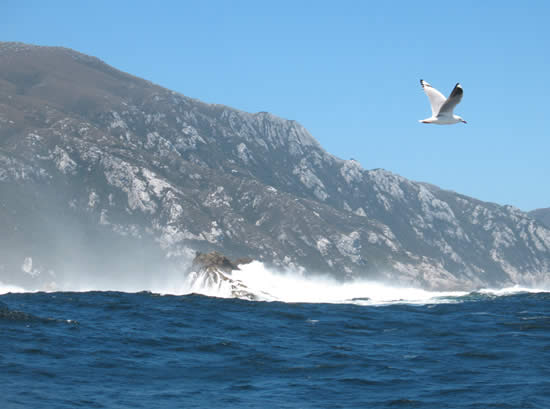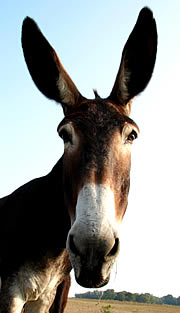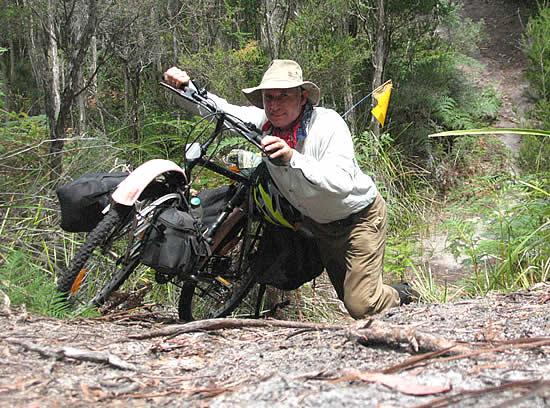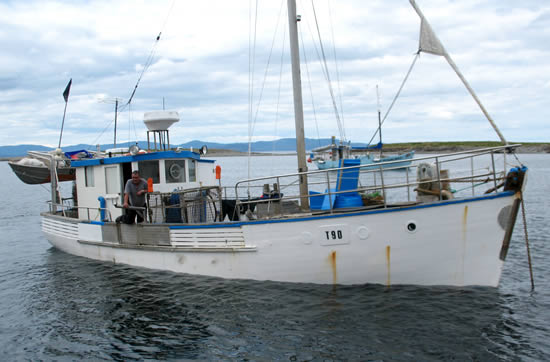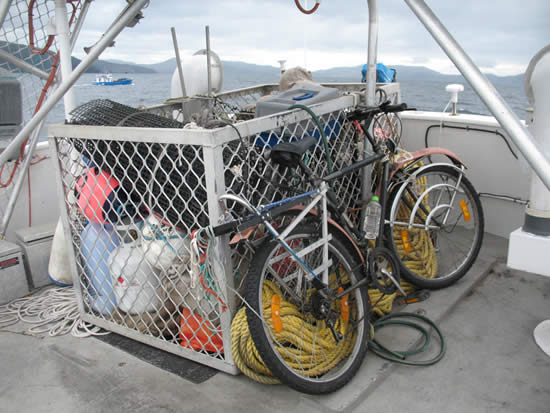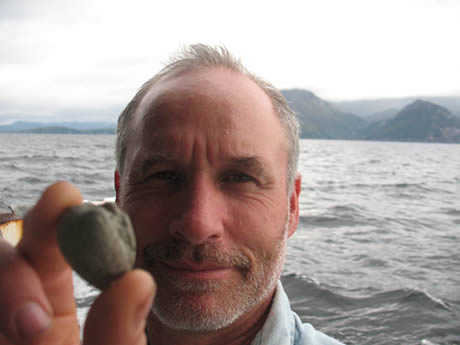It's Saturday April 20, 2024
News From The Village Updated Almost Daily
February 17, 2011
Afew months ago, writer, adventurer and part time Oriental resident Bernie Harberts left for a destination almost 10,000 miles away – Tasmania. In his pocket was a fossilized clam (found in Oriental). The goal was to travel around Tasmania, Australia’s southern-most state, by whatever means came available. The shell? That was to be deposited somewhere on his trip when the “juju was right”.
It looks a bit different than the Neuse – the view off the southern coast of Tasmania.Harberts is no stranger to travel, often beginning his voyages in Oriental. In 1998, he left Oriental aboard his steel cutter “Sea Bird”, returning to the Town Dock 5 years later having sailed alone around the world. Then he saddled up a mule – and starting again at the Town Dock, rode 13 months to San Diego.
In both cases, he carried a piece of Oriental on his journey. On the mule trip in his saddlebag he carried a bottle of Oriental harbor water. On the circumnavigation in the bilge Bernie carried a fossilized clam from Triton Yachts’ boat storage yard (where he had made final preparations for his boat voyage).Bernie’s favored mode of transportation couldn’t be foundFor his latest trip, Harberts picked up another Triton Yachts fossilized clam before leaving town. Then he flew to Tasmania, thinking he’d get another mule for transportation.
It seemed a good concept – with one significant problem. “Tasmania” Harberts says, “doesn’t have mules”.
Donkeys proved almost equally scarce, so he then looked at horses. Here he fared no better. While equines were available, they were prohibitively expensive. A suitable mount would have cost thousands of dollars, more than he was willing to pay for his planned six month journey. Bernie was spoiled by the availability of $600 mules back here in the USA.
What to do… a man needs transportation. Bernie needs it on a budget. “I went to the junk shop” he says, “and I bought an old bike and some parts to a sliding door”.
It was ten bucks.
Bernie making his way up a steep Tasmanian hill with the bicycle. Seems the lower gears don’t work… pushing does though.The bike he repaired with another one he found behind a shed. With parts from a boat shade awning and a TV aerial mount, he fashioned racks to hold his baggage. For mud guards he used a tire cut in half and folded inside out. For panniers, he used his carry-on luggage, tying daypack and VCR camera bags to the home built racks. “I tied my bags on with black string” he says “so it’s all quite fashionable”. Maybe very fashionable – for ten bucks.
With the Oriental fossil into his backpack Bernie turned his handlebars south, pedaling from Hobart, Tasmania’s capital, south toward Catamaran, on the island’s southern-eastern tip.
And so began his self-described “Journey on a Ten Dollar Bike”.
Harberts describes his first week in Tasmania as “walking uninvited into a southern hemisphere cussing festival”. What struck him as most curious wasn’t that the moon appeared “upside down” to Northern Hemisphere visitors. Or the prevalence of wallabies, solar hot water heaters and half-flush toilets that drained counterclockwise – as opposed to the other way around in North Carolina.
Rather, it was the Tasmanian’s propensity for salty language – torrents of it. The locals call it a ‘bluey‘”, he says, referring to the bouts of cursing he encountered even among young children. The exclamation “son of a buck!”, he says, “was reduced to a one word expletive – and it rhymed with one of those four words”.
Tasmania’s roots are as a penal colony… Harberts ponders “that may have something to do with it”. Gosh darn, Bernie.
Once his ears became accustomed to the talk, Bernie says “parts started falling off my bike”.
&%$#@! Bernie, whataya expect with a *&^%$#@ ten dollar bike??
In a remote stretch of gum forest, ball bearings started falling out of the bottom bracket, the assembly that supports the pedals. He pushed the bike to the nearest house where he found help – and an interview. The owner, an artist, supplied tools and axle grease with which Harberts made repairs. Then she sat down with Harberts and his audio recorder and explained how she engraves native Tasmanian orchids on large printing plates, transforming the foot-tall plants into prints almost 6 feet tall.
And so began what Harberts calls the “interview breakdown rhythm” of his trip.
Harberts, who claims to be an introvert (Publisher’s Note – he is outgoing for a shy boy), says the ten dollar bike’s constant breakdowns is the key to his meeting people. It forces him to interact with the locals. “Each time something breaks, because I travel a long way from bike shops, I have to knock on someone’s door for help”. Flat tires, slipped rear wheels, even lack of water, have resulted in interviews on leaches, Tasmanian bluegrass, pit ponies and mutton birds. These breakdowns have been overcome with dental floss, rivet guns, fishing leaders, powdered milk tin lids and shish kebab sticks.
Then there was the “curious popcorn-sounding noise” that started coming from his pedals. Figuring it was a lack of grease, Harberts stopped at Tasmania’s southernmost pub to look for lubrication.
A traditional crayfishing boat in TasmaniaWhile he didn’t find the axle grease he sought, he did end up with berth aboard a crayfish boat bound for Southern Ocean waters. For the next several weeks, Harberts lived and fished with a Tasmanian crayfishing crew (what they call crayfish look like a spiny lobster). Prized by the Chinese, the price can run to almost 50 dollars a pound on the export market. “We did two shots a day” he says, referring to the 50 crayfish traps that were set twice daily. After each set, the traps were allowed to soak for 5 to 7 hours. Then they were retrieved, the lobsters sorted, and the traps re-baited for the next shot. His ten dollar bike came along on the journey, strapped to the wooden vessel’s super structure.
The bike onboardIt was through this experience that that clam from Oriental found its final resting place.
Returning from a ten-day fishing trip off Tasmania’s rugged southern coast, Harberts felt a twinge of nostalgia as his vessel approached South East Cape, the island’s southern-most tip. “We had half a ton of crayfish in the hold and I wanted to leave something of me out there with the lobsters, Shy Albatross and Southern Ocean gales” he says. Digging the fossilized Oriental shell from his seabag, he took it to the rail and dropped it over the side.
Bernie and the clam a few moments before it became one with the Southern Ocean.Which is why, half a world away from North Carolina’s “Sailing Capital”, in hundreds of feet of water of Tasmania’s Southern Ocean, lies a tiny piece of Oriental.
After depositing his shell, Harberts has since pedaled and pushed his way up Tasmania’s East Coast. He is now at Flinders Island off northern Tasmania. Harberts plans to return to Oriental this summer, where he a frequent writer for TownDock.net. For more on Harberts’ travels and his “Postcard from Tasmania” series, visit RiverEarth.com.
